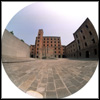 |
Risiera di San Sabba. The Risiera was constructed in 1913 as a rice-husking factory in San Sabba on the outskirts of Trieste, Italy. In 1943, German occupation forces converted the factory into a prison camp.
|

|
Entrance to the Risiera di San Sabba memorial. The present museum was designed by Romano Boico and opened in 1975. The architect described his plans in a brochure available at the memorial. "The Risiera, half destroyed by the fleeing Nazis, was squalid, like its surroundings. I thought that this total squalor could rise as a symbol and itself become a monument. I decided to remove and restore rather than add. After removing the ruined buildings I demarcated the context with 11-metre high concrete walls arranged so as to form a disquieting entrance on the same spot as the existing entrance. The walled courtyard is intended as on open-air non-denominational basilica. The building where prisoners were kept was completely emptied and the load-bearing wooden structures pared down as much as seemed necessary. The seventeen cells and the death cell are unchanged. In the central building, level with the courtyard, is the Museum of the Resistance, minimal but alive. Above the Museum, the rooms of the Deportees' Association. In the courtyard is a terrible path of steel slightly sunken—the trace of the oven, the smoke channel and the base of the chimney."
|

|
Entrance to the Risiera di San Sabba memorial.
|

|
Entrance to the Risiera di San Sabba memorial.
|

|
Looking into the courtyard at the Risiera di San Sabba. The "death cell" is to the left.
|

|
Courtyard of the Risiera di San Sabba looking back toward the entrance.
|

|
Fisheye view of the courtyard of the Risiera di San Sabba.
|

|
Fisheye view of the courtyard of the Risiera di San Sabba. The outline of the destroyed crematorium is seen in the middle of the photograph against the brick wall.
|

|
The courtyard of the Risiera di San Sabba. The outline of the destroyed crematorium is seen in the middle of the photograph against the brick wall.
|

|
The outline of the destroyed crematorium at the Risiera di San Sabba is indicated by the slightly sunken area of the pavement. Retreating Nazis dynamited the building on April 29, 1945.
|

|
Ventilation holes in bricked-up doorway of the room containing 17 mini-cells for prisoners at the Risiera di San Sabba.
|

|
Detail of ventilation holes in bricked-up doorway of the room containing 17 mini-cells for prisoners at the Risiera di San Sabba.
|

|
Courtyard of the Risiera di San Sabba looking toward the freight elevator.
|

|
Freight elevator at the Risiera di San Sabba.
|

|
Freight elevator at the Risiera di San Sabba.
|

|
Exterior building wall at the Risiera di San Sabba.
|

|
Exterior building wall at the Risiera di San Sabba.
|

|
Outline of the destroyed crematorium at the Risiera di San Sabba. The Nazis converted the original rice-drying facility into a crematorium that went into operation April 4, 1944 with the cremation of 70 bodies.
|

|
Outline of the destroyed crematorium at the Risiera di San Sabba. The oven was designed by Erwin Lambert who had previously designed a number of ovens in camps located in Poland.
|

|
Outline of the destroyed crematorium at the Risiera di San Sabba.
|

|
Center of crematorium memorial at the Risiera di San Sabba. Estimates of the number of victims murdered at the Risiera range from three thousand to five thousand.
|

|
Passage connecting the central courtyard with the exhibit are in the former garage at the Risiera di San Sabba.
|

|
Passage at the Risiera di San Sabba.
|

|
Commemoration room in the former garage at the Risiera di San Sabba.
|

|
Window at the Risiera di San Sabba.
|

|
Plan of the present memorial at the Risiera di San Sabba. The green circle is the entrance. A) "Death cell;" B) Dormitory, dressmaking shop, shoe-making shop, 17 mini-cells on the ground floor; C) Laundry, storerooms for confiscated property, dormitories for less suspect inmates and dressmaking room on upper floors; D) Outline of the former crematorium; D1) Location of former chimney; E) SS troop quarters now converted to a museum; F) Freight elevator; G) Garage now converted to commemoration room.
|
![]()

